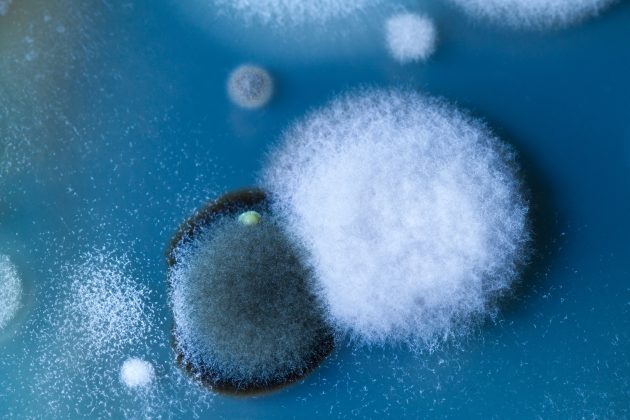Learn how to get rid of mold in your apartment, which disinfectant to choose, and how to remove the remaining smell – everything is short and to the point.
What is the mold?
Mold is a visible plaque that forms from microscopic molds. They are ubiquitous; they can grow on any material and in any condition. Mold appears not only on the surface of objects but also penetrates the mycelium with threads, so it will not always be easy to get rid of it.
What is it like?
Most often, mold in an apartment is of the following types.
- White mold. Loves flower pots, wood, bread, and some foods.
- Green mold. Prefers food.
- Blue. It appears on wood surfaces to give them a blue tint. May affect furniture, parquet, or window frames.
- Black mold. The worst kind of fungus thrives on everything from wallpaper in the bedroom to tiles in the bathroom.
Why does mold appear?
Mold begins to appear due to the following reasons.
- Humidity. The ideal level is 60-80%. In the house, there can be so much moisture.
- Temperature. Mold survives in both shallow and high temperatures. The most favorable range is from 4 to 20 ° C.
- Ventilation. Closed windows, a pile of furniture, heaps of scattered things – and now it is difficult for air to circulate the room, it is more and more saturated with mold spores, and it becomes easier for the fungus to multiply.
Read also: 7 Products That Eliminate All Kinds Of Stains
How do you know if mold has already appeared?
At first, mold can be detected by its smell – sharp, damp, and specific. In the future, the fungus gives itself out with the corresponding plaque spots.
What do you need to fight mold?
- For your own protection: glasses, gloves, respirator.
- To remove plaque: brush / sponge / scraper / cloth / sandpaper, water container, any detergent, garbage bag.
- For final treatment: fungus remover, wood varnish.
Before starting treatment of the room, put on glasses, gloves, a respirator, a protective suit will not interfere. When handling affected objects, be careful not to spread mold spores throughout your home.

How to get rid of mold?
The algorithm is straightforward.
- Mechanically clean the affected surface from plaque.
- Treat with any mold remover.
- Dry the surface and ventilate the room.
- Avoid re-formation of mold.
The most important thing is to remove any visible plaque carefully. If the mold is fresh, it can be easily removed with a sponge, brush, and warm soapy water.
Wallpaper mold can only be successfully removed in the early stages. Later, it is advisable to clean up part of the wall to plaster. Don’t hesitate! In literally a year, the fungus can infect concrete and brick, passing through the plaster. Use sandpaper for durability, and remember to dampen the walls to keep spores from spreading through the air. If mold appears on the ceiling and strikes the whitewash, clean it off with a scraper or sandpaper. Just wet the surface first.
Bathroom mold loves tile seams and joints. Scrape off the affected sealant and clean the seams. After dry, treat with a disinfectant, seal the seams and joints with new sealant and grout. Dispose of the remaining waste after processing in an airtight bag immediately. This will prevent the mold from spreading.
Which remedy for mold to choose?
The main question is; how exactly to treat the surface so that mold does not reappear? We have compiled a list of the most effective remedies, each of which acts on all fungus types. Choose the most suitable one for you.
Bleach
It is suitable for tiles, glass, but not for porous materials. It is toxic, so use it with caution. It is diluted with water in a ratio of 1:10. It is applied with a brush or with a spray bottle.
Table vinegar
It is suitable for all surfaces and materials, and it has a bad smell. It may discolor wallpaper or furniture. It is applied with a spray bottle or rag. For prevention, the procedure is repeated after a week.
Citric acid or juice
It has the same properties as vinegar and also has a pleasant smell. It is best suited for tiles. One tablespoon of citric acid is diluted in a glass of water. The solution is applied to the surface with a spray gun or rag.
Hydrogen peroxide
It is safe and easy to use. It can be applied on any surface, with care – on dyed and far too as to discolor. It is applied with a spray bottle or rag. For prevention, the procedure is repeated after a week.
Baking soda
It is safe and has no strong odor. It can be applied on any surface. A tablespoon of baking soda is diluted in a glass of water. The surface is treated with a spray gun or rag. After an hour, everything is wiped off with water to avoid streaks.
Essential oils
Tea tree, lavender, and rosemary oils have antibacterial properties and a pleasant smell; they are safe. They can work on any surface. It is enough to add 10–20 drops of oil to a glass of water and apply the solution using a spray bottle. It is better to repeat the procedure every couple of days.
How to remove mold odor?
If the mold is no longer present, but the unpleasant smell is still felt, use.
- Baking soda. Spread a thin layer over the place where the mold has grown, leave for a few hours, and then remove with a vacuum cleaner.
- Charcoal. Place several containers with coal around the perimeter of the room – in a day or two; the smell will disappear.
- Good ventilation and any scented candles, aerosols, or incense. This will help to improve the air in the house finally.
Also read: 5 Rules For Buying, Storing And Preparing Mushrooms
How to prevent mold from appearing again?
- Control room humidity. Insulate the walls and take care of waterproofing. Install an air conditioner that will dry the air. When cooking, turn on the hood, ventilate the apartment more often, especially if you are drying clothes in the bathroom.
- Maintain a stable temperature. Insulated windows and working heating will prevent condensation from forming, which fungus loves so much.
- Rearrange, disassemble the mezzanine. Free circulation of air will prevent mold from developing.
- Pay close attention to potted flowers, especially geraniums and violets. Do not overfill or use untested fertilizers.
The best assistant in detecting and preventing mold in the apartment will be light regular cleaning.
Adapted and translated by Wiki Avenue Staff
Sources: Life hacker






